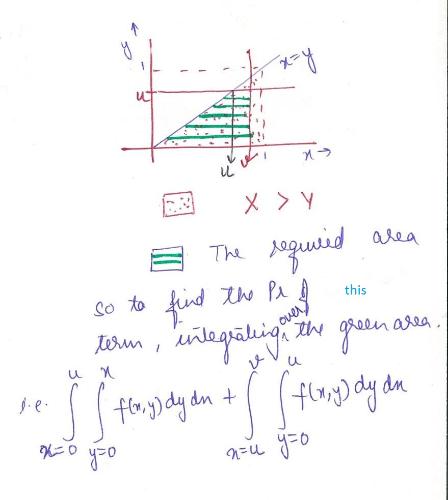Ques: X and Y are independent rv
f(x) = 2x 0<x<1
= 0 otherwise
f(y)= 3y^2 ; 0<y<1
= 0 otherwise
U=Min{X,Y} & V=Max{X,Y}. Find joint pdf of U and V.
-----
f(x,y)= 6xy^2 ; 0<x<1 & 0<y<1 (since X and Y are independent)
= 0 ; elsewhere.
F(u,v)= Pr(U<u, V<v)= Pr(U<u, V<v|X<=Y) Pr(X<=Y) + Pr(U<u, V<v|X>Y) Pr(X>Y)
Pr(U<u, V<v AND X<Y) * Pr(X<=Y) + Pr(U<u, V<v AND X>Y) * Pr(X>Y)
= -------------------------------- ---------------------------------
Pr(X<=Y) Pr(X>Y)
= Pr(U<u, V<v AND X<=Y) + Pr(U<u, V<v AND X>Y)
= Pr(Min{X,Y}<u, Max{X,Y}<v AND X<=Y) + Pr(Min{X,Y}<u, Max{X,Y}<v AND X>Y)
Pr(Min{X,Y}<u, Max{X,Y}<v AND X<=Y) :</b>

Pr(Min{X,Y}<u, Max{X,Y}<v AND X>Y):

Adding the above 4 integrals would give Pr(U<u, V<v)=F(u,v); [Assuming U<=V since Min(X,Y) <= Max(X,Y)].
---
"You don't have to believe in God, but you should believe in The Book." -Paul Erdős